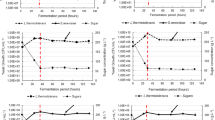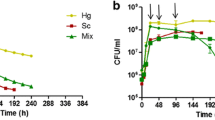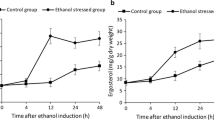Abstract
We used RNA-sequencing (RNA-seq) to analyze the expression profile of four vineyard strains of Saccharomyces cerevisiae having different fermentation performances. The expression profiles obtained in two steps of the fermentation process were compared with those obtained for the industrial wine strain EC1118 and for the laboratory strain S288c. The two strains with low fermentation efficiency, namely, S288c and the vineyard strain R103, exhibited markedly different expression profiles when compared to the other four strains. We also found that the vineyard strains P283 and P301 are characterized by a high expression of the transcription factor Met32p in the first step of the fermentation. Met32p, in coordination with the Hap4p transcription factor, determined the over-expression of the genes involved in the respiration processes, in the response to oxidative stress and in the sulfur amino acids biosynthesis. These combined actions are likely to increase the level of antioxidants whose protective effect could contribute to improve the fermentation process. Gene expression and phenotypic data revealed that the vineyard strain P301 has low nitrogen utilization in comparison to the other wine strains, combined with high fermentation efficiency. Analysis of the genes involved in fermentation stress response revealed a lower expression in strains characterized by low fermentation efficiency, particularly in the first fermentation phase. These findings evidenced the high variability of transcriptional profiles among different wine yeast strains and clarify their connection with complex phenotypic traits, such as the fermentation efficiency and the nitrogen sources utilization.







Similar content being viewed by others
Explore related subjects
Discover the latest articles and news from researchers in related subjects, suggested using machine learning.References
Abdulrehman D, Monteiro PT, Teixeira MC, Mira NP, Lourenço AB, dos Santos SC, Cabrito TR, Francisco AP, Madeira SC, Aires RS, Oliveira AL, Sá-Correia I, Freitas AT (2011) YEASTRACT: providing a programmatic access to curated transcriptional regulatory associations in Saccharomyces cerevisiae through a web services interface. Nucleic Acids Res 39:D136–D140
Alexandre H, Rousseaux I, Charpentier C (1994) Ethanol adaptation mechanisms in Saccharomyces cerevisiae. Biotechnol Appl Biochem 20:173–183
Ambroset C, Petit M, Brion C, Sanchez I, Delobel P, Guérin C, Chiapello H, Nicolas P, Bigey F, Dequin S (2011) Deciphering the molecular basis of wine yeast fermentation traits using a combined genetic and genomic approach. G3. Genes Genome Genet 1:263–281
Andreasen AA, Stier T (1953) Anaerobic nutrition of Saccharomyces cerevisiae: I. Ergosterol requirement for growth in a defined medium. J Cell Comp Physiol 41:23–36
Bely M, Sablayrolles J, Barre P (1990) Automatic detection of assimilable nitrogen deficiencies during alcoholic fermentation in oenological conditions. J Ferment Bioeng 70:246–252
Bourot S, Karst F (1995) Isolation and characterization of the Saccharomyces cerevisiae SUT1 gene involved in sterol uptake. Gene 165:97–102
Brauer MJ, Saldanha AJ, Dolinski K, Botstein D (2005) Homeostatic adjustment and metabolic remodeling in glucose-limited yeast cultures. Mol Biol Cell 16:2503–2517
Campagna D, Albiero A, Bilardi A, Caniato E, Forcato C, Manavski S, Vitulo N, Valle G (2009) PASS: a program to align short sequences. Bioinformatics 25:967–968
Causton HC, Ren B, Koh SS, Harbison CT, Kanin E, Jennings EG, Lee TI, True HL, Lander ES, Young RA (2001) Remodeling of yeast genome expression in response to environmental changes. Mol Biol Cell 12:323–337
Cingolani P, Platts A, Coon M, Nguyen T, Wang L, Land SJ, Lu X, Ruden DM (2012) A program for annotating and predicting the effects of single nucleotide polymorphisms, SnpEff: SNPs in the genome of Drosophila melanogaster strain w1118; iso-2; iso-3. Fly 6:80–92
Coffman JA, Rai R, Cunningham T, Svetlov V, Cooper TG (1996) Gat1p, a GATA family protein whose production is sensitive to nitrogen catabolite repression, participates in transcriptional activation of nitrogen-catabolic genes in Saccharomyces cerevisiae. Mol Cell Biol 16:847–858
Cooper TG (2002) Transmitting the signal of excess nitrogen in Saccharomyces cerevisiae from the Tor proteins to the GATA factors: connecting the dots. FEMS Microbiol Rev 26:223–238
Crépin L, Nidelet T, Sanchez I, Dequin S, Camarasa C (2012) Sequential use of nitrogen compounds by Saccharomyces cerevisiae during wine fermentation: a model based on kinetic and regulation characteristics of nitrogen permeases. Appl Environ Microbiol 78:8102–8111
DeRisi JL, Iyer VR, Brown PO (1997) Exploring the metabolic and genetic control of gene expression on a genomic scale. Science 278:680–686
Des Gachons CP, Leeuwen CV, Tominaga T, Soyer J, Gaudillère J, Dubourdieu D (2005) Influence of water and nitrogen deficit on fruit ripening and aroma potential of Vitis vinifera L cv Sauvignon blanc in field conditions. J Sci Food Agric 85:73–85
Filipe-Ribeiro L, Mendes-Faia A (2007) Validation and comparison of analytical methods used to evaluate the nitrogen status of grape juice. Food Chem 100:1272–1277
Forsburg SL, Guarente L (1989) Identification and characterization of HAP4: a third component of the CCAAT-bound HAP2/HAP3 heteromer. Genes Dev 3:1166–1178
Gasch AP, Spellman PT, Kao CM, Carml-Harel O, Eisen MB, Storz G, Botstein D, Brown PO (2000) Genomic expression programs in the response of yeast cells to environmental changes. Sci Signal 11:4241–4257
Goffeau A, Barrell BG, Bussey H, Davis RW, Dujon B, Feldmann H, Galibert F, Hoheisel JD, Jacq C, Johnston M, Louis EJ, Mewes HW, Murakami Y, Philippsen P, Tettelin H, Oliver SG (1996) Life with 6000 genes. Science 274:546–567
Hofman-Bang J (1999) Nitrogen catabolite repression in Saccharomyces cerevisiae. Mol Biotechnol 12:35–71
Hu X, Wang M, Tan T, Li J, Yang H, Leach L, Zhang R, Luo Z (2007) Genetic dissection of ethanol tolerance in the budding yeast Saccharomyces cerevisiae. Genetics 175:1479–1487
Ivorra C, Pérez‐Ortín JE, del Olmo M (1999) An inverse correlation between stress resistance and stuck fermentations in wine yeasts. A molecular study. Biotechnol Bioeng 64:698–708
Li H, Handsaker B, Wysoker A, Fennell T, Ruan J, Homer N, Marth G, Abecasis G, Durbin R (2009) The sequence alignment/map format and SAMtools. Bioinformatics 25:2078–2079
Li B, Cheng J, Ding M, Yuan Y (2010) Transcriptome analysis of differential responses of diploid and haploid yeast to ethanol stress. J Biotechnol 148:194–203
Magasanik B, Kaiser CA (2002) Nitrogen regulation in Saccharomyces cerevisiae. Gene 290:1–18
Maris AJ, Bakker BM, Brandt M, Boorsma A, Teixeira de Mattos MJ, Grivell LA, Pronk JT, Blom J (2001) Modulating the distribution of fluxes among respiration and fermentation by overexpression of HAP4 in Saccharomyces cerevisiae. FEMS Yeast Res 1:139–149
Marks VD, Ho Sui SJ, Erasmus D, van der Merwe GK, Brumm J, Wasserman WW, Bryan J, van Vuuren HJ (2008) Dynamics of the yeast transcriptome during wine fermentation reveals a novel fermentation stress response. FEMS Yeast Res 8:35–52
Mendes-Ferreira A, Del Olmo M, Garcia-Martinez J, Jimenez-Marti E, Mendes-Faia A, Perez-Ortin J, Leao C (2007) Transcriptional response of Saccharomyces cerevisiae to different nitrogen concentrations during alcoholic fermentation. Appl Environ Microbiol 73:3049–3060
Mortazavi A, Williams BA, McCue K, Schaeffer L, Wold B (2008) Mapping and quantifying mammalian transcriptomes by RNA-Seq. Nat Methods 5:621–628
Mortimer RK (2000) Evolution and variation of the yeast (Saccharomyces) genome. Genome Res 10:403–409
Nagalakshmi U, Wang Z, Waern K, Shou C, Raha D, Gerstein M, Snyder M (2008) The transcriptional landscape of the yeast genome defined by RNA sequencing. Science 320:1344–1349
Neilsen GH, Neilsen D, Bowen P, Bogdanoff C, Usher K (2010) Effect of timing, rate, and form of N fertilization on nutrition, vigor, yield, and berry yeast-assimilable N of grape. Am J Enol Vitic 61:327–336
Ning Z, Cox AJ, Mullikin JC (2001) SSAHA: a fast search method for large DNA databases. Genome Res 11:1725–1729
Novo M, Bigey F, Beyne E, Galeote V, Gavory F, Mallet S, Cambon B, Legras JL, Wincker P, Casaregola S, Dequin S (2009) Eukaryote-to-eukaryote gene transfer events revealed by the genome sequence of the wine yeast Saccharomyces cerevisiae EC1118. Proc Natl Acad Sci U S A 106:16333–16338
Petti AA, Crutchfield CA, Rabinowitz JD, Botstein D (2011) Survival of starving yeast is correlated with oxidative stress response and nonrespiratory mitochondrial function. Proc Natl Acad Sci U S A 108:E1089–E1098
Petti AA, McIsaac RS, Ho-Shing O, Bussemaker HJ, Botstein D (2012) Combinatorial control of diverse metabolic and physiological functions by transcriptional regulators of the yeast sulfur assimilation pathway. Mol Biol Cell 23:3008–3024
Reimand J, Vaquerizas JM, Todd AE, Vilo J, Luscombe NM (2010) Comprehensive reanalysis of transcription factor knockout expression data in Saccharomyces cerevisiae reveals many new targets. Nucleic Acids Res 38:4768–4777
Rospert S, Glick BS, Jenö P, Schatz G, Todd MJ, Lorimer GH, Viitanen PV (1993) Identification and functional analysis of chaperonin 10, the groES homolog from yeast mitochondria. Proc Natl Acad Sci U S A 90:10967–10971
Rossignol T, Dulau L, Julien A, Blondin B (2003) Genome-wide monitoring of wine yeast gene expression during alcoholic fermentation. Yeast 20:1369–1385
Saeed AI, Bhagabati NK, Braisted JC, Liang W, Sharov V, Howe EA, Li J, Thiagarajan M, White JA, Quackenbush J (2006) TM4 microarray software suite. Methods Enzymol 411:134–193
Schure EG, Riel NA, Verrips CT (2000) The role of ammonia metabolism in nitrogen catabolite repression in Saccharomyces cerevisiae. FEMS Microbiol Rev 24:67–83
Spayd S, Nagel C, Edwards C (1995) Yeast growth in Riesling juice as affected by vineyard nitrogen fertilization. Am J Enol Vitic 46:49–55
Takagi H, Shichiri M, Takemura M, Mohri M, Nakamori S (2000) Saccharomyces cerevisiae sigma 1278b has novel genes of the N-acetyltransferase gene superfamily required for l-proline analogue resistance. J Bacteriol 182:4249–4256
Thomas D, Surdin-Kerjan Y (1997) Metabolism of sulfur amino acids in Saccharomyces cerevisiae. Microbiol Mol Biol Rev 61:503–532
Thorsness M, Schafer W, d'Ari L, Rine J (1989) Positive and negative transcriptional control by heme of genes encoding 3-hydroxy-3-methylglutaryl coenzyme A reductase in Saccharomyces cerevisiae. Mol Cell Biol 9:5702–5712
Treu L, Toniolo C, Nadai C, Sardu A, Giacomini A, Corich V, Campanaro S (2013) The impact of genomic variability on gene expression in environmental Saccharomyces cerevisiae strains. Environ Microbiol. doi:10.1111/1462-2920.12327
Turi T, Loper J (1992) Multiple regulatory elements control expression of the gene encoding the Saccharomyces cerevisiae cytochrome P450, lanosterol 14 α-demethylase (ERG11). J Biol Chem 267:2046–2056
Vainberg IE, Lewis SA, Rommelaere H, Ampe C, Vandekerckhove J, Klein HL, Cowan NJ (1998) Prefoldin, a chaperone that delivers unfolded proteins to cytosolic chaperonin. Cell 93:863–873
van Voorst F, Houghton‐Larsen J, Jønson L, Kielland‐Brandt MC, Brandt A (2006) Genome-wide identification of genes required for growth of Saccharomyces cerevisiae under ethanol stress. Yeast 23:351–359
Wang L, Feng Z, Wang X, Wang X, Zhang X (2010) DEGseq: an R package for identifying differentially expressed genes from RNA-seq data. Bioinformatics 26:136–138
Wilcox LJ, Balderes DA, Wharton B, Tinkelenberg AH, Rao G, Sturley SL (2002) Transcriptional profiling identifies two members of the ATP-binding cassette transporter superfamily required for sterol uptake in yeast. J Biol Chem 277:32466–32472
Young ET, Dombek KM, Tachibana C, Ideker T (2003) Multiple pathways are co-regulated by the protein kinase Snf1 and the transcription factors Adr1 and Cat8. J Biol Chem 278:26146–26158
Zuzuarregui A, Carrasco P, Palacios A, Julien A, Olmo M (2005) Analysis of the expression of some stress induced genes in several commercial wine yeast strains at the beginning of vinification. J Appl Microbiol 98:299–307
Acknowledgments
RNA-seq was performed at the CRIBI Biotechnology Centre (University of Padua) and we acknowledge the support of Michela D’Angelo in processing our samples. Fermentation curves and enological analysis were performed at the CIRVE laboratories of Conegliano (Treviso, Italy) and we acknowledge the support of Barbara Bovo and Milena Carlot. This work was supported by the University of Padua [CPDA082991] and by the Provincia di Treviso providing PhD fellowship. We express thanks to Georgine Faulkner of the Department of Biology (University of Padua) for her assistance in the manuscript revision.
Author information
Authors and Affiliations
Corresponding author
Additional information
L. Treu and S. Campanaro contributed equally to this work.
Rights and permissions
About this article
Cite this article
Treu, L., Campanaro, S., Nadai, C. et al. Oxidative stress response and nitrogen utilization are strongly variable in Saccharomyces cerevisiae wine strains with different fermentation performances. Appl Microbiol Biotechnol 98, 4119–4135 (2014). https://doi.org/10.1007/s00253-014-5679-6
Received:
Revised:
Accepted:
Published:
Issue Date:
DOI: https://doi.org/10.1007/s00253-014-5679-6
Keywords
Profiles
- Stefano Campanaro View author profile
- Chiara Toniolo View author profile
- Tiziana Nardi View author profile




